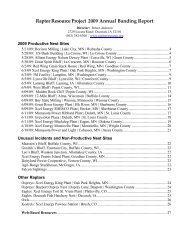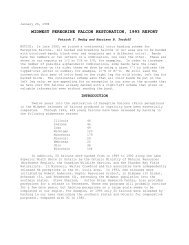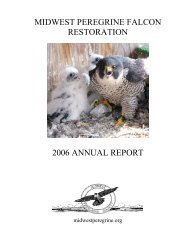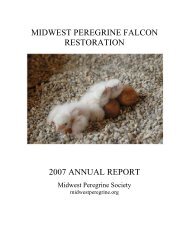2002 - Midwest Peregrine Falcon Restoration Project
2002 - Midwest Peregrine Falcon Restoration Project
2002 - Midwest Peregrine Falcon Restoration Project
Create successful ePaper yourself
Turn your PDF publications into a flip-book with our unique Google optimized e-Paper software.
2<br />
Tordoff maintains the <strong>Midwest</strong> peregrine database and wrote the narrative and<br />
Tables 1 and 2 in this report. Martell prepared Tables 3 and 4 and managed printing and<br />
circulation of the report. Castrale prepared Figures 1 through 14, based on a separate<br />
database kept by him.<br />
All peregrines banded in the U.S. <strong>Midwest</strong> (ND, MN, WI, MI, SD, NE, IA, IL,<br />
IN, OH, KS, MO, KY) in <strong>2002</strong> wear a bicolored project band, black over green, on the<br />
left leg. Wild-produced birds have a purple anodized USFWS band on the right leg;<br />
hacked birds have a gold anodized USFWS band on the right leg. In Canada (SE MB,<br />
NW ON), hacked birds receive a red band and wild-produced birds get a black band, in<br />
addition to the usual silver USFWS band.<br />
Many of the black/green and black/red bands have the upper or lower character<br />
(or both) tipped to the left on its side; these we show by using a star (*) to indicate the<br />
tipped-over letter or number, for example, *2/E or H/*4. It is essential to include the star<br />
because all combinations are in use (H/4, *H/4, H/*4, *H/*4 for example). It is also<br />
important to put all bands on right side up, to make them easier to read in the field. To<br />
avoid confusion, numerals take precedence over letters; that is, numerals 1 and 0 are used<br />
on the project color bands, letters I and O are not used.<br />
We cannot change names of localities in the peregrine database when the names<br />
of buildings or companies change. The original names are entered in the database in too<br />
many places. Incomplete corrections would confuse searches for data. The same goes<br />
for individual birds -- once named, the name sticks.<br />
INTRODUCTION<br />
Although the winter was mild, a cold, snowy spring in the <strong>Midwest</strong>, especially in<br />
the northern part, resulted in some failed nests and some re-nesting by <strong>Peregrine</strong> <strong>Falcon</strong>s<br />
(Falco peregrinus). The production of fledged young was down in North Dakota,<br />
Minnesota, and Wisconsin but remained about steady in the next tier of states south,<br />
Nebraska east to Ohio. The known territorial pairs rose from 133 to 144, the second year<br />
of slow growth. Production of young declined from 290 to 284. The same percentage of<br />
territorial pairs nested this year (89% in 2001 and <strong>2002</strong>) with somewhat reduced success<br />
(83% this year vs. 86% in 2001) in fledging at least one young. Here is a nesting<br />
summary for eight years by state or province (sequence here and in the main list below is<br />
north tier of states first, west to east; second tier, etc., then SE Manitoba and NW<br />
Ontario).








